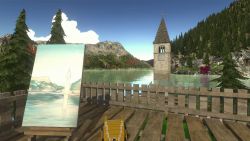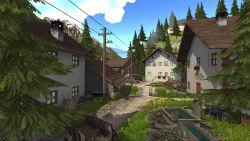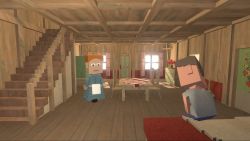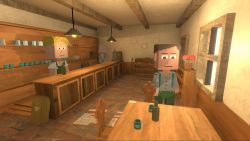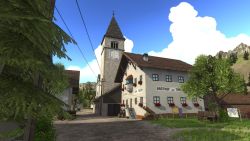|
By flotsam
Self described as a game about love,
resistance and historical memory, A Painter’s Tale delivers about two
hours of peaceful, poignant story telling.
There
is a puzzle or two, and a task or three to complete, but it leans
towards being a guided story. A good one at that. One about how things
can be more than just possessions, and places more than somewhere we
live, contributing to who we are.
Curon
is/was a real village in the South Tyrol region of Italy, near to the
borders with Austria and Switzerland. In 1950 it was flooded as part of
building a hydro-electric dam, and rebuilt nearby. Most buildings were
demolished before being submerged, although a Romanesque bell tower
dating from the 1300’s protrudes from the lake to this day.
It is
here we find Tommaso, a present day painter capturing the scene. He is
drawn to the waters edge by a strange light, where he is dragged beneath
the waters to awaken in the village prior to its destruction. Taken in
by the locals, a kindly Ida in particular, the rest of the two hours
sees Tommaso uncover the details of what occurred, and the impact it had
on the villagers. He wants to help, but he also wants to get home, and
the imminent lake could be the key.
This
is less though about Tommaso and more about the tale of the town. The
game has been developed as part of a project to utilise games to
catalogue places and stories mapping Italy’s cultural heritage. (Google
IVIPRO if you want to know more). The little town had been recreated
from photos in the new town’s museum, and allowing for the voxelly
nature of the graphics a rather faithful job has been done.
Art
not surprisingly features, utilising actual drawings and oil paintings.
You can view these as you “collect” them through your journal.
Historical factoids about the village will also be stored there, and
both these can be accessed in game or from the main menu. There aren’t a
huge number, and you can ignore them if you want, but they do add both
detail and context. The musing on the art can also be insightful.
While
there are only a few, objectives are also kept here, should you need to
review them.
The
elephant in the room is the character modelling. They look like large
Duplo beings, but with square heads and sharp voxelly edges. I got used
to it, although when Tommaso came up close and almost pressed his face
against my screen it was a tad disconcerting all over again.
Speaking of which, your view of the game world is a little all over the
shop. You have no control over the camera, which will change its view
point to suit itself. Mostly its fine, giving you a third person
perspective from a distance that enables you to navigate appropriately,
but not always. There was at least one occasion where the camera tended
to spin around as I turned Tommaso, giddy being the least of my issues,
and the top down close up perspective of Ida at the end game was
gimmicky and unnecessary. As well, not only can Tommaso get really close
and intimate, at other times he will run off into the distance, getting
ever smaller and causing you to wander when the screen will change. He
can also disappear out of screen altogether without triggering a change
in the camera, all of which is manageable but just be aware.
Edges
of some buildings are also not sacrosanct, and at one point Tommaso
scampered up a tree. But it remained a charming tale.
A
Painter’s Tale plays exclusively with the keyboard (throw that pesky
mouse away!) and autosaves as you go. Watch for the little SD card image
top left. I would have liked it to have saved a little more regularly,
but it wasn’t a big deal having to play some short segments again if I
exited before a save point. There is no spoken words, dialogue being
displayed in a ribbon at the bottom of the screen and advanced with the
Enter key. Shift to run and WASD to move Tommaso (and Ida in the end
game) around. Some musical pieces accompany things.
I did
enjoy my time with Tommaso and his tale, and the broader project is a
worthy one.
I played on:
OS: Windows 10, 64 Bit
Processor: Intel i7-9700K 3.7GHz
RAM: Corsair Dominator Platinum RGB DDR4 32GB
Video card: AMD Radeon RX 580 8192MB
GameBoomers Review Guidelines
March 2021
design copyright© 2021
GameBoomers
Group
 GB
Reviews Index GB
Reviews Index |
